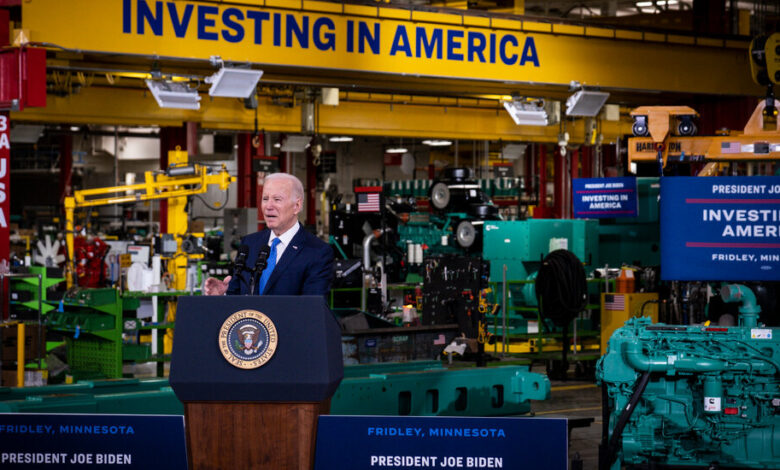
[ad_1]
The Biden administration on Friday issued its long-awaited plan to provide lucrative tax breaks to companies that make hydrogen, a clean-burning fuel, proposing new rules meant to ensure that the policy doesn’t inadvertently lead to a spike in planet-warming emissions.
Hydrogen is widely seen as a promising tool to tackle climate change, as long as it can be produced without creating any greenhouse gases. When burned, hydrogen mainly emits water vapor, and it could be used instead of fossil fuels to make steel or fertilizer, or to power large trucks or ships.
But making hydrogen requires energy, and very little so-called clean hydrogen exists today. Currently, most hydrogen is made from natural gas in a process that emits planet-warming carbon dioxide.
Congress approved a tax credit last year to encourage companies to make more hydrogen from renewable energy and other carbon-free sources, setting off fierce lobbying by businesses focused on who should be able to claim the credit.
Experts have warned that some companies could claim to use wind or solar power to make hydrogen while indirectly causing emissions to go up, and they urged safeguards to prevent that. Some industry groups wanted more lenient rules around the credit, so that a broader range of projects could qualify.
In the guidance issued on Friday, the Treasury Department largely sided with those urging tighter restrictions.
To qualify for the full tax credit, companies would typically need to use clean electricity from newly built sources, such as wind and solar farms, to run electrolyzers that split water into oxygen and hydrogen. Starting in 2028, those electrolyzers would have to run during the same hours that the wind or solar farms were operating.
Many hydrogen developers and environmental groups praised the proposal. Without those restrictions, they said, hydrogen producers could draw vast amounts of power from the existing grid and trigger a spike in greenhouse gas emissions if coal- or gas-fired power plants had to run more often.
“The U.S. has the highest tax subsidy for hydrogen in the world, so we think it should have the highest stringency for what counts as clean,” said Eric Guter, vice president of hydrogen for Air Products & Chemicals Inc., the world’s largest producer of hydrogen. The company is developing a $4 billion project with AES in North Texas that will use wind and solar energy to generate hydrogen.
But other industry groups criticized the rules, saying they could prevent many early hydrogen projects from being developed.
The American Clean Power Association, which represents major wind, solar and transmission companies, said the requirement to match hydrogen production with clean electricity on an hourly basis by 2028 was too stringent.
That provision “will discourage a significant majority of clean power companies from investing in green hydrogen manufacturing and facilities,” Jason Grumet, chief executive of the group, said in a statement.
The Treasury Department will accept comments from the public for 60 days and could make changes before finalizing the plan.
Some nuclear power producers, for instance, had asked that the tax credits be available for hydrogen made from existing nuclear plants. But the administration postponed a decision on that question, instead asking the industry for more information. Very few nuclear plants are expected to be built in the near future.
Cost is currently the biggest hurdle to making hydrogen cleanly. While some companies around the world have used wind, solar or nuclear power plants to run electrolyzers and make hydrogen without any emissions, that process costs around $4 to $6 per kilogram of hydrogen. That’s about two to three times as expensive as making it with natural gas.
The hydrogen tax credit was meant to bridge that gap and jump-start a new industry, by providing up to $3 for every kilogram of “clean” hydrogen that companies produce over the course of a decade.
But defining what counts as “clean” turned out to be contentious.
Most of America’s electricity still comes from coal and natural gas plants, so if a company were simply to plug a bunch of electrolyzers into the existing grid to make hydrogen, emissions would very likely rise. Similarly, if a hydrogen company tried to use electricity from an existing wind or solar farm, other coal or gas plants might have to run more often to compensate for the lost power. Without safeguards, several studies suggested, the tax credits could inadvertently lead to hundreds of millions of tons of extra carbon dioxide being emitted.
To avoid that outcome, the Treasury Department proposed several restrictions. To earn the full tax credit, hydrogen producers would have to draw on new sources of clean electricity built within the past three years. That could include a new wind farm or investments that expanded the capacity of an existing nuclear plant. Those plants would have to be located in the same grid region as the hydrogen factory. And, starting in 2028, the electrolyzers could only run in the same hours that the clean power was available.
Some hydrogen companies said the proposed rules could be difficult to follow. Wind and solar power don’t run all the time, and trying to match hydrogen output to renewable fluctuations on an hourly basis would increase costs, they said.
“This policy will make it harder for everyone,” said Jacob Susman, chief executive of Ambient Fuels, a clean hydrogen developer that had been planning roughly $700 million in new projects. Still, he said his company would try to work with the new rules.
Other companies and experts said the new rules around hourly matching could spur innovation. One U.S. startup, Electric Hydrogen, is making an electrolyzer designed to ramp up and down with solar and wind output. The new rules could give that sort of technology a leg up over the less-flexible electrolyzers made in China, the company said.
“There will be a lobbying blitz around the final rule,” said Rachel Fakhry, policy director for emerging technologies at the Natural Resources Defense Council, an environmental group. “We’re watching closely to make sure there aren’t any new loopholes that will be harmful for emissions or consumers.”
It is still unclear how much clean hydrogen the United States will actually produce in the coming years. Although the Biden administration has laid out a strategy to produce 50 million tons of clean hydrogen by 2050, more than 50 times what is produced today, there are steep obstacles, including setting up systems to transport hydrogen and finding buyers for the fuel.
To that end, the Energy Department is also spending $7 billion to create hydrogen hubs around the country to connect producers and buyers, while setting up programs to stimulate demand for hydrogen and reduce the cost of electrolyzers.
“There are an awful lot of tools in our clean hydrogen tool belt that we didn’t have before,” said David Turk, the deputy secretary of energy. “There’s a huge opportunity here.”
Source link




